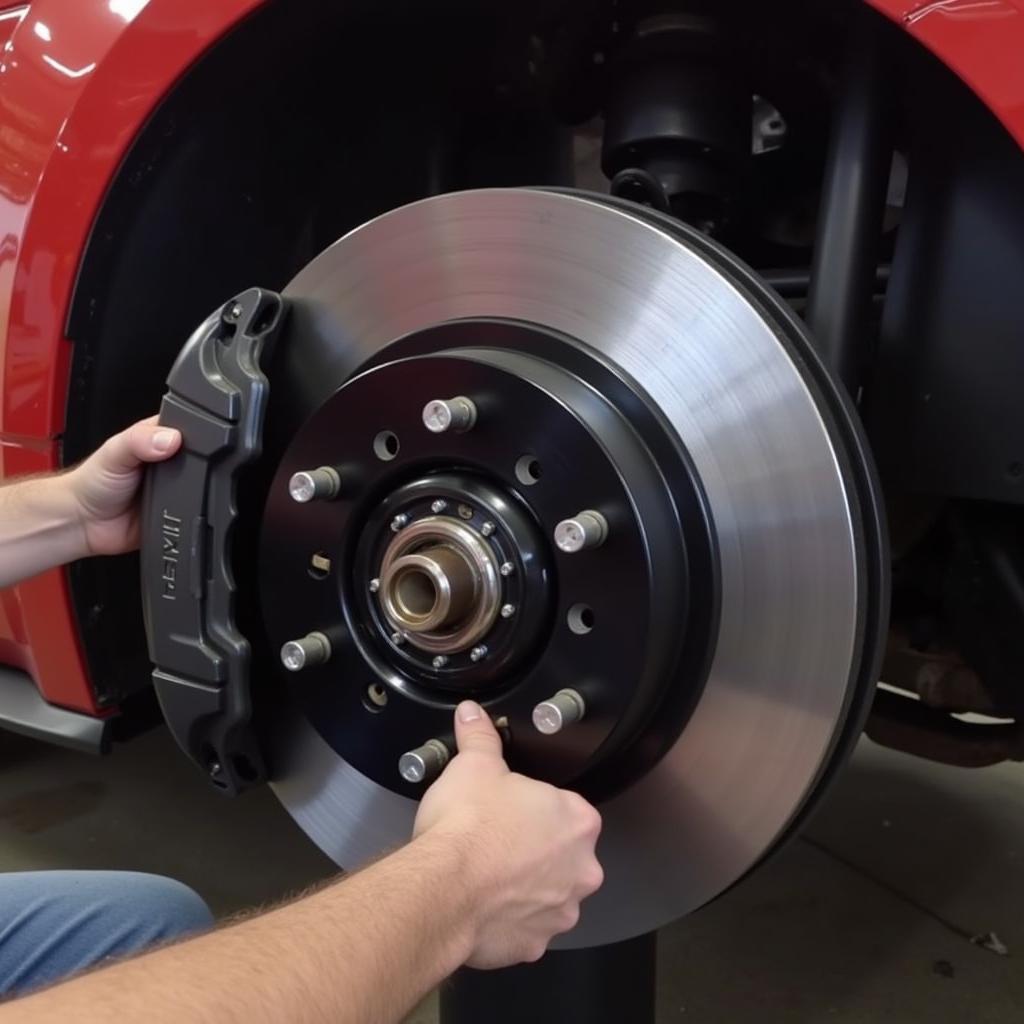If you’re driving a 2016 Mustang GT and seeing the dreaded “Low Brake Fluid” warning light flickering on and off, you’re not alone. This can be a frustrating and potentially dangerous issue, but don’t panic just yet. This article will walk you through the common causes of this problem and provide step-by-step solutions to help you get back on the road safely.
Understanding the Low Brake Fluid Warning
Your Mustang’s braking system relies on hydraulic pressure to function properly. When the brake fluid level drops below a certain point, the car’s computer triggers the “Low Brake Fluid” warning light on your dashboard. This is a serious safety concern, as low brake fluid can significantly reduce braking performance, potentially leading to an accident.
Common Causes of Intermittent Low Brake Fluid Warnings in a 2016 Mustang GT
While a genuine leak in the brake system is a possibility, an intermittent low brake fluid warning in a 2016 Mustang GT often points to other issues:
- Worn Brake Pads: As your brake pads wear down, the brake calipers need to extend further to apply the same amount of pressure to the rotors. This increased extension requires more brake fluid, potentially triggering the low fluid warning, even if there’s no actual leak.
- Faulty Brake Fluid Level Sensor: The sensor in the brake fluid reservoir that detects the fluid level can malfunction. A faulty sensor might send incorrect signals to the car’s computer, resulting in an intermittent warning light.
- Air in the Brake Lines: If air gets trapped in the brake lines, it can compress, leading to a spongy brake pedal feel and a drop in fluid level. This can cause the low brake fluid warning to come on, even if the fluid level is technically sufficient.
 Brake Fluid Reservoir
Brake Fluid Reservoir
Troubleshooting the Issue
Before you start working on your car’s braking system, remember that brakes are critical for safety. If you’re not comfortable performing these checks yourself, it’s best to consult a qualified mechanic.
1. Check Your Brake Fluid Level:
- Park your Mustang on a level surface and engage the parking brake.
- Open the hood and locate the brake fluid reservoir.
- Check the fluid level against the “Min” and “Max” markings on the reservoir. If the level is below the “Min” mark, you’ll need to add more brake fluid.
2. Inspect for Leaks:
- Carefully examine the area around the brake fluid reservoir, brake lines, and calipers for any signs of leaks. Look for wet spots, drips, or fluid residue.
- If you find a leak, it’s crucial to address it immediately by a professional mechanic.
 Inspecting Brake Lines for Leaks
Inspecting Brake Lines for Leaks
3. Check Your Brake Pads:
- If the fluid level appears normal and there are no visible leaks, inspect your brake pads.
- You can visually check the pad thickness through the spaces between the wheel spokes.
- If the brake pads are worn thin, they’ll need to be replaced.
4. Consider a Brake Fluid Flush:
- Brake fluid absorbs moisture over time, which can affect its performance and potentially damage brake components.
- If you can’t remember the last time your brake fluid was flushed, it’s a good idea to have it done as part of routine maintenance.
When to Seek Professional Help
If you’ve performed these checks and are still experiencing the intermittent low brake fluid warning, it’s best to consult a professional mechanic specializing in Ford vehicles. They can accurately diagnose the issue using specialized equipment and perform any necessary repairs.
“Remember, any issue related to your brakes is serious and should be addressed immediately. Ignoring a brake warning light can lead to costly repairs and, more importantly, compromise your safety on the road,” advises John Miller, a seasoned Ford mechanic with over 20 years of experience.
FAQs:
1. Can I drive my Mustang with the low brake fluid warning light on?
It’s not recommended. Driving with low brake fluid can significantly reduce your braking power, increasing the risk of an accident.
2. How often should I check my brake fluid?
It’s a good practice to check your brake fluid level at least once a month, or more frequently if you notice any changes in your brake pedal feel.
3. What type of brake fluid does a 2016 Mustang GT use?
Your 2016 Mustang GT uses DOT 3 brake fluid. Using the wrong type of brake fluid can damage your brake system.
4. How much does it cost to fix a low brake fluid warning?
The cost of repair depends on the underlying cause. A simple brake fluid top-up might cost a few dollars, while repairing a leak or replacing faulty components can be significantly more expensive.
5. Can I add brake fluid myself?
Yes, you can add brake fluid yourself, but make sure to use the correct type of fluid and follow the instructions in your owner’s manual.
 Replacing Brake Pads on a 2016 Mustang GT
Replacing Brake Pads on a 2016 Mustang GT
Conclusion
An intermittent low brake fluid warning light in your 2016 Mustang GT shouldn’t be ignored. By understanding the potential causes and following the troubleshooting steps outlined in this article, you can address the issue promptly and ensure your safety on the road. Remember, if you’re ever in doubt, it’s always best to consult a qualified mechanic for assistance.
